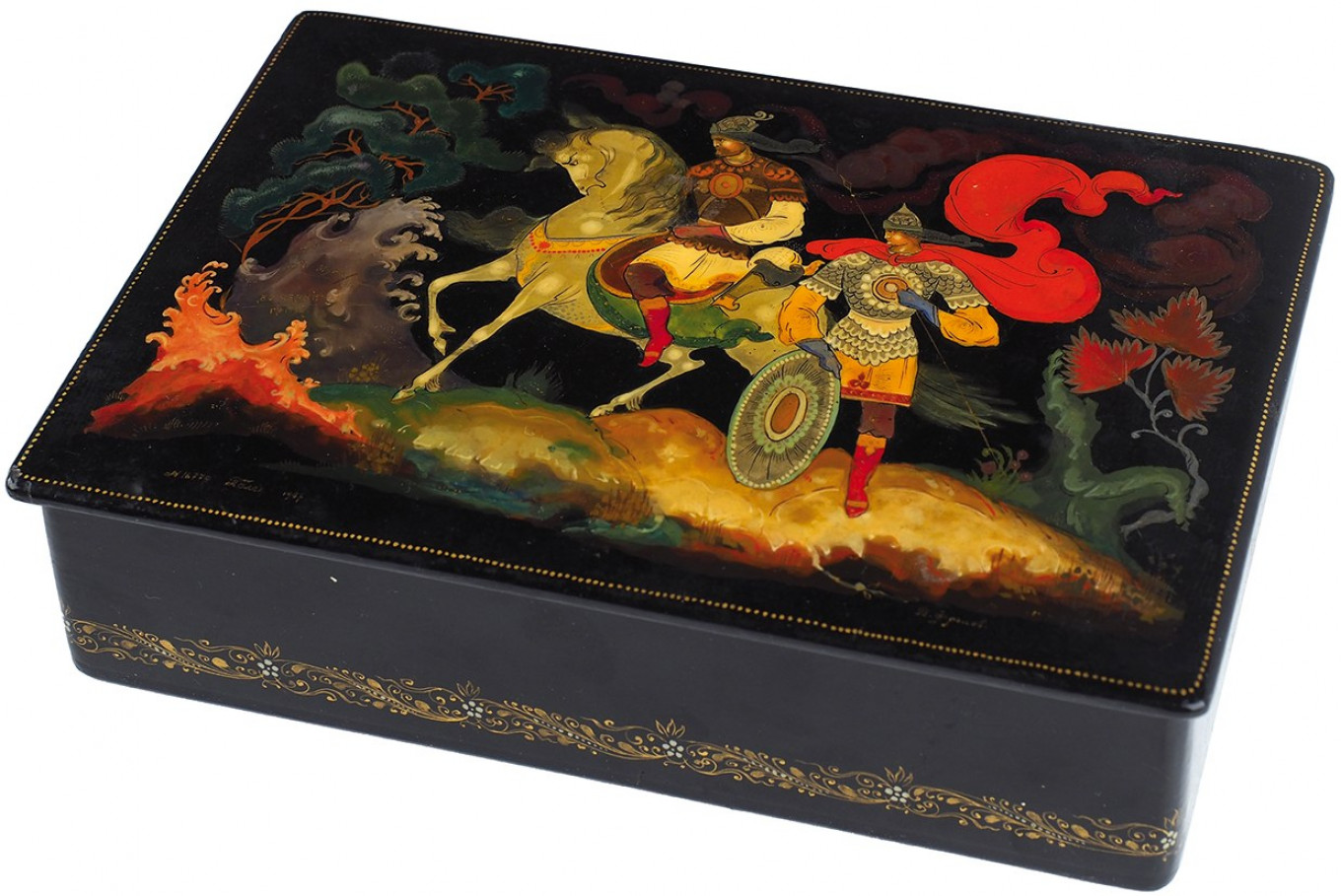Painted lacquer boxes are one of Russia’s most typical crafts, found in rows on vendors’ tables next to the matryoshka dolls and wooden toys. You might think of them as another mass-produced souvenir for the tourists — but you’d be wrong. These boxes with miniature paintings of landscapes, fairy tales and scenes from Russian literature are handmade by village families that were once icon painters.
From icons to troikas
Legend has it that icon painters in Suzdal and Vladimir fled the attacking Tatar-Mongol armies in the 13th century and settled on the Paleshka River in a town that would become Palekh. That might not be true, but it is a fact that the town, along with Kholui and Mstera, was famous for the icon-painters, who were even invited to Moscow to paint some of the Kremlin palaces and churches.
But that all ended with the 1917 Revolution and the destruction of the Orthodox Church. In the early 1920s, a Moscow artist named Ivan Golikov came to the rescue of the village painters. After seeing Asian miniatures at an exhibition in the capital, he had the idea of “retraining” the icon painters to use their formidable skills and talent on secular boxes. In Palekh, the artists used tempera paint on wooden boxes and only began to use papier-mâché as a base in 1923 when they formed an artel, or cooperative.
Papier-mâché came from the town of Fedoskino, not far from Moscow, where more than 200 years ago Ivan Korobov established a factory to produce lacquer works. The factory passed down through the heirs as the Lukutin Factory, which was synonymous with lacquer boxes until the Vishnyakov family began competing with them. Both factories produced boxes that were made of papier-mâché and painted with oil paints (not tempera, as in Palekh). The artists often used gold and other metal powders to give the boxes their trademark mother-of-pearl or translucent sheen.
In the 1930s and 1940s two more towns joined in this industry: Mstera and Kholui. During the Soviet period, some of the most elaborate boxes sold for tens of thousands of dollars. It is estimated that the Soviet government earned more than $1 million a year selling these lacquered miniatures to foreign tourists visiting Russia and foreign collectors abroad.
Today the pendulum of taste has swung away from these miniature masterpieces, and the youngest members of village families who have made boxes and icons for countless generations are applying their talent and skills to more lucrative endeavors. But wise collectors and lovers of objets d’art continue to search the markets and shops for the most beautiful little boxes.

Four centers, four styles
Each town and artel that produces lacquer boxes has its own style that has developed over the decades. Fedoskino boxes often have a translucent light-colored background. By tradition, the paintings are quite realistic, with figures of people and animals in correct proportions. Themes include landscapes, portraits, troikas, and some scenes from fairy tales.
After almost a century, Palekh boxes still show the influence of the icons painted by the ancestors of today’s artists. The background of the box is almost always black, the figures are often elongated and graceful (like the figures of saints), and the animals are usually stylized. Boxes are extraordinarily ornate, with gold ornaments and decorations covering all the borders and often the painting itself. The colorful paintings show scenes from fairy tales, literary works and sometimes life in villages.

The masters of Kholui, originally a rug-making center, began to make lacquer boxes only in the late 1940s. Their work is warmer in color than Palekh or Fedoskino: yellow, brown and red make up their favorite palette. The favorite theme is the landscape, usually painted rather realistically.
Mstera boxes began to appear in the early 1930s when the town's icon-painters found themselves without work. Traditionally Mstera boxes never use black backgrounds. The ground is often light blue or pink, and their landscapes and other images are generally more realistic than the mannered figures from Palekh. Mstera boxes are renowned for their multi-colored tree leaves and delicate, scant use of gold ornamentation.
But is it real?
If an ornate lacquer box is very cheap (under $50) — chances are it’s not real. It is probably wooden, chipboard or plastic (not papier-mâché) with a decoupage (glued on paper) ornament. But sometimes expensive boxes are fakes, too. Here’s how to distinguish a real one.
- Pick it up. It should be very light.
- Tap it. Wood, plastic and chipboard give off a sharp crack. Papier-mâché has a soft, muted sound. That’s what you want to hear.
- Sniff it. It should smell of linseed oil.
- Rub your fingers over the painting. It should be completely smooth, with no edges.
- Find the artist’s signature and the date the box was made.
For more information about lacquer boxes in Russian, see the artisans' site.
A Message from The Moscow Times:
Dear readers,
We are facing unprecedented challenges. Russia's Prosecutor General's Office has designated The Moscow Times as an "undesirable" organization, criminalizing our work and putting our staff at risk of prosecution. This follows our earlier unjust labeling as a "foreign agent."
These actions are direct attempts to silence independent journalism in Russia. The authorities claim our work "discredits the decisions of the Russian leadership." We see things differently: we strive to provide accurate, unbiased reporting on Russia.
We, the journalists of The Moscow Times, refuse to be silenced. But to continue our work, we need your help.
Your support, no matter how small, makes a world of difference. If you can, please support us monthly starting from just $2. It's quick to set up, and every contribution makes a significant impact.
By supporting The Moscow Times, you're defending open, independent journalism in the face of repression. Thank you for standing with us.
Remind me later.







